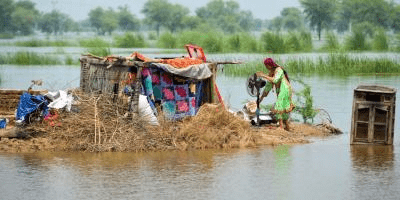
The Pakistani leaders are rejoicing as the country steps into its 23rd IMF program. Some local papers are carrying the news that the funds will give a major fillip to the economy. The ruling class is boasting of the achievement as if begging for money accounts for economic growth.
As the upper echelons are heaving a sign of relief in the comfort of their homes, the rest of Pakistan is waning in literal darkness and misery. PM Shebaz Sharif declared the international donors’ conference in Geneva a “success” and promised that every rupee pledged will account for flood victims as if somehow this will redeem his respect and goodwill among the awaam.
Farmers swimming in the worst-hit areas of Sindh find it hard to believe that they would receive “even one rupee” of what is promised.
The rulers are already trying to bank votes in the name of these funds that are only pledged, not delivered, fooling people. They are building castles in the air, giving them hope for the money which will be remitted over three years, not immediately. For the donors such as the Islamic Developmental Bank which pledged $4.2 billion, the pledge acts as a safety net, an excuse out of the promise if they feel they cannot commit to this huge number. A pledge does not bind them to pay, it is not an agreement. This fact and many such conditions on the $10 billion pledged, is probably a minuscule detail for the political leaders who have left out this information as it doesn’t benefit their agenda.
Speaking to a national daily, former Finance Minister Miftah Ismail claimed that the “government is not only forcing us further into a debt trap but risks defaulting on repayment”. Pakistan already owes the world about $100 billion,
$21 billion of which is due to be repaid to the creditors in this fiscal year. As 2023 unfolds, the nation is bound to repeat the vicious cycle of borrowing from one creditor to pay off another, only to buy more time to pay the original amount while slowly driving itself off the cliff.
The country found itself in a similar situation during the 2005 earthquakes when a Conference on Rehabilitation and Reconstruction of the affected areas pledged $3.5 billion. Pakistan could not benefit from the pledged amount and neither could produce any reports as to why. 17 years on, the victims who had to bear the brunt are living in makeshift homes in “Azad” Jammu-Kashmir without any permanent infrastructure, electricity, or water facilities. Most of the children have not seen the inside of a classroom.
Pakistani elites live like there is no tomorrow while the awaam macerates in
the clogged drains.
Balochistan is gripped at -10 to -17 degrees Celcius. The water pipelines have burst due to frozen water; frosty highways and link roads are slippery and dangerous, restricting movement; Siberian winds are posing health concerns to areas such as Chaman and Ziarat of northern Balochistan; only 25 percent of Balochistan has access to drinking water; the province with the largest gas fields is forced to return to the cavemen method of keeping themselves warm
– Fire. And the list goes on. This is only the state of one province.
In the past three days due to a major power breakdown in major cities of Pakistan including Karachi, Lahore, Islamabad, and Quetta the status of citizens has been reduced to that of animals and insects fighting on the streets for a morsel of bread braving the cold. Reportedly 90 percent of Karachi is without power. And according to a leading news channel Geo News, “All the transmission lines supplying electricity to Balochistan have tripped”. People are running wild stealing wheat and pulses owing to inflation. Flour is disappearing from the storage hideouts where it was held to fetch higher prices in ignorance of the hungry population.
It wouldn’t come as a surprise if national-level riots hit the streets tomorrow calling out fake promises of the unpopular government. In its Global Crisis Risk Report, the World Economic Forum fears that Pakistan’s institutions will be inactive and perjured within two years. The rich will flee to their secure hamlets abroad and the poor will be left behind to pay off the accumulated debt. The treasury is already empty. And the political tug of war has the flood victims on the brink of death and the rest of the nation in severe crisis. The burning question is – given the generous donation of the international community, will Pakistan be able to redeem itself or default again and remain a global joke?







